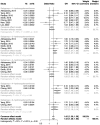The Association between Urinary Polycyclic Aromatic Hydrocarbons Metabolites and Type 2 Diabetes Mellitus
- PMID: 35805265
- PMCID: PMC9265723
- DOI: 10.3390/ijerph19137605
The Association between Urinary Polycyclic Aromatic Hydrocarbons Metabolites and Type 2 Diabetes Mellitus
Abstract
Polycyclic aromatic hydrocarbons (PAHs) are considered to be endocrine disruptors. In this study, the evidence on the association between PAHs and diabetes was systematically reviewed. PubMed, EMBASE, and ISI Web of Science were systematically searched for studies reporting the association between PAHs and diabetes. Of the 698 articles identified through the search, nine cross-sectional studies were included. Seven were conducted in the general population and two in coke oven workers. Fixed-effects and random-effects models were used to calculate the total effect. Subgroup analysis was further carried out according to the types of PAH metabolites. The results showed that the odds of diabetes were significantly higher for the highest category of urinary naphthalene (NAP), fluorine (FLU), phenanthrene (PHEN), and total mono-hydroxylated (OH-PAH) metabolites compared to the lowest category. The pooled odds ratios (OR) and 95% confidence intervals (CI) were 1.52 (95%CI: 1.19, 1.94), 1.53 (95%CI: 1.36, 1.71), 1.43 (95%CI: 1.28, 1.60), and 1.49 (95%CI: 1.07, 2.08), respectively. In coke oven workers, 4-hydroxyphenanthrene (4-OHPh) was significantly correlated with an increased risk of diabetes. Exposure measurements, outcome definitions, and adjustment for confounders were heterogeneous between studies. The results of the current study demonstrate a potentially adverse effect of PAHs on diabetes. Further mechanistic studies and longitudinal studies are needed to confirm whether PAH metabolite levels are causative, and hence associative, with increased diabetes incidences.
Keywords: diabetes; environmental pollutants; mono-hydroxylated PAHs (OH-PAHs); polycyclic aromatic hydrocarbons (PAHs).
Conflict of interest statement
The authors declare no conflict of interest.
Figures





Similar articles
-
The association between urinary metabolites of polycyclic aromatic hydrocarbons and diabetes: A systematic review and meta-analysis study.Chemosphere. 2020 May;247:125680. doi: 10.1016/j.chemosphere.2019.125680. Epub 2020 Jan 8. Chemosphere. 2020. PMID: 32069705
-
Association of polycyclic aromatic hydrocarbons metabolites and risk of diabetes in coke oven workers.Environ Pollut. 2017 Apr;223:305-310. doi: 10.1016/j.envpol.2017.01.027. Epub 2017 Jan 26. Environ Pollut. 2017. PMID: 28131481
-
Polycyclic aromatic hydrocarbons, long non-coding RNA expression, and DNA damage in coke oven workers.Environ Sci Pollut Res Int. 2022 Aug;29(38):57277-57286. doi: 10.1007/s11356-022-19828-1. Epub 2022 Mar 29. Environ Sci Pollut Res Int. 2022. PMID: 35349071
-
Urinary 1-hydroxypyrene as a comprehensive carcinogenic biomarker of exposure to polycyclic aromatic hydrocarbons: a cross-sectional study of coke oven workers in China.Int Arch Occup Environ Health. 2014;87(7):705-13. doi: 10.1007/s00420-013-0913-6. Epub 2013 Oct 12. Int Arch Occup Environ Health. 2014. PMID: 24122095
-
The association between internal polycyclic aromatic hydrocarbons exposure and risk of Obesity-A systematic review with meta-analysis.Chemosphere. 2023 Jul;329:138669. doi: 10.1016/j.chemosphere.2023.138669. Epub 2023 Apr 12. Chemosphere. 2023. PMID: 37059208
Cited by
-
Association between urinary polycyclic aromatic hydrocarbon metabolites and premature menopause: a nationally representative cross-sectional study in the United States.Environ Health Prev Med. 2025;30:32. doi: 10.1265/ehpm.25-00031. Environ Health Prev Med. 2025. PMID: 40335317 Free PMC article.
-
Endocrine-Disrupting Chemicals and Disease Endpoints.Int J Mol Sci. 2023 Mar 10;24(6):5342. doi: 10.3390/ijms24065342. Int J Mol Sci. 2023. PMID: 36982431 Free PMC article. Review.
-
Environmental contamination with polycyclic aromatic hydrocarbons and contribution from biomonitoring studies to the surveillance of global health.Environ Sci Pollut Res Int. 2024 Sep;31(42):54339-54362. doi: 10.1007/s11356-024-34727-3. Epub 2024 Aug 29. Environ Sci Pollut Res Int. 2024. PMID: 39207613 Free PMC article. Review.
-
Associations of urinary polycyclic aromatic hydrocarbon (PAH) metabolites and their mixture with thyroid hormone concentration during pregnancy in the LIFECODES cohort: A repeated measures study.Environ Res. 2024 Aug 15;255:119205. doi: 10.1016/j.envres.2024.119205. Epub 2024 May 21. Environ Res. 2024. PMID: 38782334 Free PMC article.
References
-
- Cohen A.J., Brauer M., Burnett R., Anderson H.R., Frostad J., Estep K., Balakrishnan K., Brunekreef B., Dandona L., Dandona R., et al. Estimates and 25-year trends of the global burden of disease attributable to ambient air pollution: An analysis of data from the Global Burden of Diseases Study 2015. Lancet. 2017;389:1907–1918. doi: 10.1016/S0140-6736(17)30505-6. - DOI - PMC - PubMed
Publication types
MeSH terms
Substances
LinkOut - more resources
Full Text Sources
Medical
Research Materials

